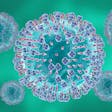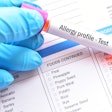
The recent survey, “Triple Inhaled Therapy in Asthma: Beliefs, Behaviors and Doubts,” is shedding light on clinicians’ opinions, uncertainties and actions in recommending the use of triple inhaled therapy (ITT) for the treatment of asthma. The survey results were recently published in the journal, Pulmonary Pharmacology & Therapeutics.
ITT combines inhaled corticosteroids (ICS), long-acting beta-2 agonists (LABA) and long-acting muscarinic antagonists (LAMA). Several treatable traits of asthma, such as propensity to exacerbations, airflow limitation, neuronal plasticity, small airway dysfunction, mucus hypersecretion and neutrophilic airway inflammation, can be addressed by inhaled triple therapy. Despite its proven efficacy, ITT is not widely adopted in clinical practice, according to survey investigators.
 Diego Bagnasco, MD, PhD
Diego Bagnasco, MD, PhD
Dr. Bagnasco and colleagues conducted an ad hoc survey developed by Interasma Scientific Network (INESnet) and refined through two Delphi rounds.
The survey, which was distributed through Interasma's social media channels between June and September 2023, gathered responses from 314 clinicians across 47 countries. The findings revealed that although 35.7% of specialists consider ITT a relevant therapeutic option, 30.9% rarely or never prescribe it. Additionally, 61.8% view ITT as a second option after high-dose ICS-LABA therapy. Despite a consensus on whether biologics should be administered in combination with ITT, survey results found that 89.2% of clinicians agree that ITT should be optimized before resorting to biological drugs.
According to the survey results, persistent flow limitation and high reversibility were identified as predictive factors for a positive response to ITT. However, they also highlighted significant uncertainties among clinicians regarding the timing and criteria for prescribing ITT. For example, 48.4% of clinicians reported stepping down from high-dose ICS-LABA or high-dose ICS-ITT to medium-dose ITT, while 35.7% rarely or never do so.
Additional findings suggest that ITT is underutilized, with 71.3% of clinicians surveyed believing it is not prescribed enough. This trend is consistent with data from the Severe Asthma Network Registry Italy (SANI), where only 40% of severe asthma patients receive LAMAs, regardless of whether they are also on biological drugs.
According to investigators, the survey highlights both the potential and the challenges of ITT in asthma management. While ITT is recognized for its efficacy in improving lung function and reducing exacerbations, investigators said they believe there is a need for robust guidelines and better integration of research findings into clinical practice. Addressing these uncertainties can help optimize the use of ITT and improve patient outcomes.























